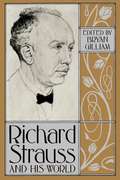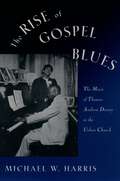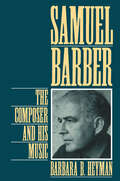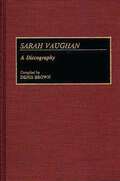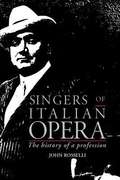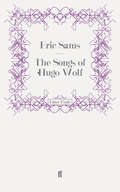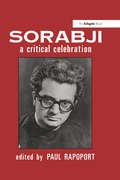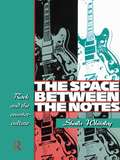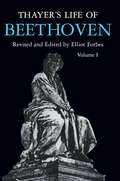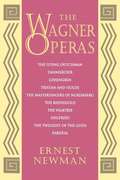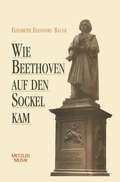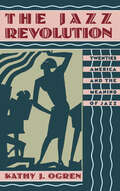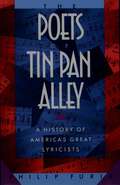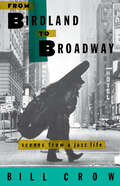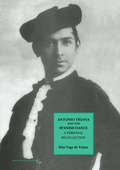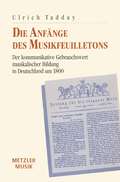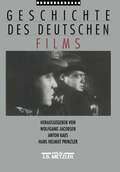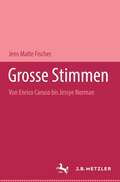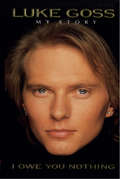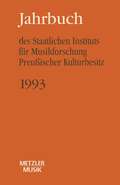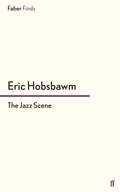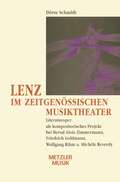- Table View
- List View
Richard Strauss and His World
by Bryan GilliamStrongly influencing European musical life from the 1880s through the First World War and remaining highly productive into the 1940s, Richard Strauss enjoyed a remarkable career in a constantly changing artistic and political climate. This volume presents six original essays on Strauss's musical works--including tone poems, lieder, and operas--and brings together letters, memoirs, and criticism from various periods of the composer's life. Many of these materials appear in English for the first time. In the essays Leon Botstein contradicts the notion of the composer's stylistic "about face" after Elektra; Derrick Puffett reinforces the argument for Strauss's artistic consistency by tracing in the tone poems and operas the phenomenon of pitch specificity; James Hepokoski establishes Strauss as an early modernist in an examination of Macbeth; Michael Steinberg probes the composer's political sensibility as expressed in the 1930s through his music and use of such texts as Friedenstag and Daphne; Bryan Gilliam discusses the genesis of both the text and the music in the final scene of Daphne; Timothy Jackson in his thorough source study argues for a new addition to the so-called Four Last Songs. Among the correspondence are previously untranslated letters between Strauss and his post-Hofmannsthal librettist, Joseph Gregor. The memoirs range from early biographical sketches to Rudolf Hartmann's moving account of his last visit with Strauss shortly before the composer's death. Critical reviews include recently translated essays by Theodor Adorno, Guido Adler, Paul Bekker, and Julius Korngold.
The Rise of Gospel Blues: The Music of Thomas Andrew Dorsey in the Urban Church
by Michael W. HarrisMost observers believe that gospel music has been sung in African-American churches since their organization in the late 1800s. Yet nothing could be further from the truth, as Michael W. Harris's history of gospel blues reveals. Tracing the rise of gospel blues as seen through the career of its founding figure, Thomas Andrew Dorsey, Harris tells the story of the most prominent person in the advent of gospel blues. Also known as "Georgia Tom," Dorsey had considerable success in the 1920s as a pianist, composer, and arranger for prominent blues singes including Ma Rainey. In the 1930s he became involved in Chicago's African-American, old-line Protestant churches, where his background in the blues greatly influenced his composing and singing. Following much controversy during the 1930s and the eventual overwhelming response that Dorsey's new form of music received, the gospel blues became a major force in African-American churches and religion. His more than 400 gospel songs and recent Grammy Award indicate that he is still today the most prolific composer/publisher in the movement. Delving into the life of the central figure of gospel blues, Harris illuminates not only the evolution of this popular musical form, but also the thought and social forces that forged the culture in which this music was shaped.
Samuel Barber: The Composer and His Music
by Barbara B. HeymanSamuel Barber (1910-1981) was one of the most important and honored American composers of the twentieth century. Writing in a great variety of musical forms--symphonies, concertos, operas, vocal music, and chamber music--he infused his works with poetic lyricism and gave tonal language and forms new vitality. His rich legacy includes such famous compositions as the Adagio for Strings, the orchestral song Knoxville: Summer of 1915, three concertos, and his two operas, the Pulitzer Prize-winning Vanessa and Antony and Cleopatra, a commissioned work that opened the new Metropolitan Opera House at Lincoln Center. Generously documented by letters, sketchbooks, original musical manuscripts, and interviews with friends, colleagues and performers with whom he worked, this is the first book to cover Barber's entire career and all of his compositions. The biographical material on Barber is closely interspersed with a discussion of his music, displaying Barber's creative processes at work from his early student compositions to his mature masterpieces. Heyman also provides the social context in which this major composer grew: his education, how he built his career, the evolving musical tastes of American audiences, his relationship to musical giants like Serge Koussevitzky, and the role of radio in the promotion of his music. A testament to the significance of the new Romanticism, Samuel Barber stands as a model biography of an important American musical figure.
Sarah Vaughan: A Discography (Discographies: Association for Recorded Sound Collections Discographic Reference)
by Denis BrownA true labor of love and appreciation for Sarah Vaughan's vast contributions to American popular music, this comprehensive discography documents some 750 songs recorded by Vaughan in 221 recording sessions between 1944 and 1989, some of them multiple times. The artist, when presented with an early draft of this volume a few years before her death, called it a piece of gold and commented that there were songs she'd forgotten and would record again.Information on orchestra leaders, arrangers, musicians, matrix numbers, and record company catalog numbers is given, and separate sections organize the material by record company issues and index song titles (with composers), musicians, and orchestras. This work will be of interest to scholars and researchers of popular music, to record collectors, and to everyone who loves the music of Sarah Vaughan.
Singers of Italian Opera: The History of a Profession (PDF)
by John RosselliJohn Rosselli's wide-ranging study introduces all those singers, members of the chorus as well as stars, who have sung Italian opera from 1600 to the present. Where did they come from? How were they trained? What did they earn, and what pressures shaped their careers? Singers are shown slowly emancipating themselves from dependence on great patrons and entering the dangerous freedom of the market. The castrati who dominated eighteenth-century opera turn out to be more conscientious and professional than their previous reputation as extravagant, vain creatures has suggested. The book examines the sexist prejudices against them and against women singers - who in the early days of opera were presumed to be courtesans and sometimes were. But for women, opera provided one of the very few professional and economic opportunities.
The Songs of Hugo Wolf
by Eric SamsWith a foreword by the legendary accompanist, Gerald Moore, Eric Sams' study (Faber 1961, revised 1983) is a notable landmark in the establishment of Wolf as one of the supreme masters of German song. Comprehensively revised and enlarged in 1983, the main subject matter remains the 242 published songs that Wolf wrote for voice and piano, though the Ibsen songs for voice and orchestra are also discussed.English translations are provided and the backgrounds to the original poems by Morike, Eichendorff and Goethe, as well as the Italian and Spanish sources from which the songbooks were drawn, are fully explored. Each song is dated, its keys identified and vocal range determined.'This is the most important book in the English language on the songs of Hugo Wolf since Ernest Newman proclaimed the composer's genius in 1907 . . . To the English-speaking student this work is a treasure to which he will find himself returning again and again: it is indispensable to those of us anxious to gain a deeper knowledge of Wolf.' Gerald Moore
Sorabji: A Critical Celebration
by Paul RapoportKaikhosru Shapurji Sorabji (1892-1988) was an unusual legend in his own lifetime: a Parsi composer and critic living in England whose compositions are of such length and difficulty that he felt compelled to ban public performances of them. This book, the first devoted to Sorabji, explores his life and character, his music, his articles and letters. It both presents the legend accurately and dispels its exaggerated aspects. The portrait which emerges is not of a crank or eccentric but of a highly original and accomplished musical thinker whom recent performances and recordings confirm as unique and important. Most of the contributors knew Sorabji personally. They have all written about or performed his music, gaining international recognition for their work. Generous quotation of Sorabji's published and unpublished music and prose assists in bringing him and his work strikingly to life. The book also contains the most complete and accurate register of his work ever published.
Sorabji: A Critical Celebration
by Paul Rapoport Alistair Hinton Frank Holliday Kenneth Derus Nazlin Bhimani Michael Habermann Geoffrey Douglas Madge Marc-André RobergeKaikhosru Shapurji Sorabji (1892-1988) was an unusual legend in his own lifetime: a Parsi composer and critic living in England whose compositions are of such length and difficulty that he felt compelled to ban public performances of them. This book, the first devoted to Sorabji, explores his life and character, his music, his articles and letters. It both presents the legend accurately and dispels its exaggerated aspects. The portrait which emerges is not of a crank or eccentric but of a highly original and accomplished musical thinker whom recent performances and recordings confirm as unique and important. Most of the contributors knew Sorabji personally. They have all written about or performed his music, gaining international recognition for their work. Generous quotation of Sorabji's published and unpublished music and prose assists in bringing him and his work strikingly to life. The book also contains the most complete and accurate register of his work ever published.
The Space Between the Notes: Rock and the Counter-Culture
by Sheila WhiteleyThe Space Between the Notes examines a series of relationships central to sixties counter-culture: psychedelic coding and rock music, the Rolling Stones and Charles Manson, the Beatles and the `Summers of love', Jimi Hendrix and hallucinogenics, Pink Floyd and space rock. Sheila Whiteley combines musicology and socio-cultural analysis to illuminate this terrain, illustrating her argument with key recordings of the time: Cream's She Walks Like a Bearded Rainbow, Hendrix's Hey Joe, Pink Floyd's Set the Controls For the Heat of the Sun, The Move's I Can Hear the Grass Grow, among others.The appropriation of progressive rock by young urban dance bands in the 1990s make this study of sixties and seventies counter-culture a timely intervention. It will inform students of popular music and culture, and spark off recognition and interest from those that lived through the period as well as a new generation that draw inspiration from its iconography and sensibilities today.
The Space Between the Notes: Rock and the Counter-Culture
by Sheila WhiteleyThe Space Between the Notes examines a series of relationships central to sixties counter-culture: psychedelic coding and rock music, the Rolling Stones and Charles Manson, the Beatles and the `Summers of love', Jimi Hendrix and hallucinogenics, Pink Floyd and space rock. Sheila Whiteley combines musicology and socio-cultural analysis to illuminate this terrain, illustrating her argument with key recordings of the time: Cream's She Walks Like a Bearded Rainbow, Hendrix's Hey Joe, Pink Floyd's Set the Controls For the Heat of the Sun, The Move's I Can Hear the Grass Grow, among others.The appropriation of progressive rock by young urban dance bands in the 1990s make this study of sixties and seventies counter-culture a timely intervention. It will inform students of popular music and culture, and spark off recognition and interest from those that lived through the period as well as a new generation that draw inspiration from its iconography and sensibilities today.
Thayer's Life of Beethoven, Part I
by Elliot ForbesThe book description for the previously published "Thayer's Life of Beethoven" is not yet available.
The Wagner Operas
by Ernest NewmanIn this classic guide, the foremost Wagner expert of our century discusses ten of Wagner's most beloved operas, illuminates their key themes and the myths and literary sources behind the librettos, and demonstrates how the composer's style changed from work to work. Acclaimed as the most complete and intellectually satisfying analysis of the Wagner operas, the book has met with unreserved enthusiasm from specialist and casual music lover alike. Here, available for the first time in a single paperback volume, is the perfect companion for listening to, or attending, The Flying Dutchman, Tannhäuser, Lohengrin, Tristan and Isolde, Die Meistersinger, the four operas of the Ring Cycle, and Parsifal. Newman enriches his treatment of the stories, texts, and music of the operas with biographical and historical materials from the store of knowledge that he acquired while completing his numerous books on Wagner, including the magisterial Life of Richard Wagner. The text of The Wagner Operas is filled with hundreds of musical examples from the scores, and all the important leitmotifs and their interrelationships are made clear in Newman's lucid prose. "This is as fine an introduction as any ever written about a major composer's masterpieces. Newman outlines with unfailing clarity and astuteness each opera's dramatic sources, and he takes the student through the completed opera, step by step, with all manner of incidental insight along the way."--Robert Bailey, New York University
Wie Beethoven auf den Sockel kam: Die Entstehung eines musikalischen Mythos
by Elisabeth Eleonore BauerThe Jazz Revolution: Twenties America and the Meaning of Jazz
by Kathy J. OgrenBorn of African rhythms, the spiritual "call and response," and other American musical traditions, jazz was by the 1920s the dominant influence on this country's popular music. Writers of the Harlem Renaissance (Langston Hughes, Claude McKay, Zora Neale Hurston) and the "Lost Generation" (Malcolm Cowley, F. Scott Fitzgerald, and Gertrude Stein), along with many other Americans celebrated it--both as an expression of black culture and as a symbol of rebellion against American society. But an equal number railed against it. Whites were shocked by its raw emotion and sexuality, and blacks considered it "devil's music" and criticized it for casting a negative light on the black community. In this illuminating work, Kathy Ogren places this controversy in the social and cultural context of 1920s America and sheds new light on jazz's impact on the nation as she traces its dissemination from the honky-tonks of New Orleans, New York, and Chicago, to the clubs and cabarets of such places as Kansas City and Los Angeles, and further to the airwaves. Ogren argues that certain characteristics of jazz, notably the participatory nature of the music, its unusual rhythms and emphasis, gave it a special resonance for a society undergoing rapid change. Those who resisted the changes criticized the new music; those who accepted them embraced jazz. In the words of conductor Leopold Stowkowski, "Jazz [had] come to stay because it [was] an expression of the times, of the breathless, energetic, superactive times in which we [were] living, it [was] useless to fight against it." Numerous other factors contributed to the growth of jazz as a popular music during the 1920s. The closing of the Storyville section of New Orleans in 1917 was a signal to many jazz greats to move north and west in search of new homes for their music. Ogren follows them to such places as Chicago, New York, and San Francisco, and, using the musicians' own words as often as possible, tells of their experiences in the clubs and cabarets. Prohibition, ushered in by the Volstead Act of 1919, sent people out in droves to gang-controlled speak-easies, many of which provided jazz entertainment. And the 1920s economic boom, which made music readily available through radio and the phonograph record, created an even larger audience for the new music. But Ogren maintains that jazz itself, through its syncopated beat, improvisation, and blue tonalities, spoke to millions. Based on print media, secondary sources, biographies and autobiographies, and making extensive use of oral histories, The Jazz Revolution offers provocative insights into both early jazz and American culture.
The Poets of Tin Pan Alley: A History of America's Great Lyricists
by Philip FuriaFrom the turn of the century to the 1960s, the songwriters of Tin Pan Alley dominated American music. Irving Berlin, Cole Porter, George and Ira Gershwin, Rodgers and Hart--even today these giants remain household names, their musicals regularly revived, their methods and styles analyzed and imitated, and their songs the bedrock of jazz and cabaret. In The Poets of Tin Pan Alley Philip Furia offers a unique new perspective on these great songwriters, showing how their poetic lyrics were as important as their brilliant music in shaping a golden age of American popular song. Furia writes with great perception and understanding as he explores the deft rhymes, inventive imagery, and witty solutions these songwriters used to breathe new life into rigidly established genres. He devotes full chapters to all the greats, including Irving Berlin, Lorenz Hart, Ira Gershwin, Cole Porter, Oscar Hammerstain II, Howard Dietz, E.Y. Harburg, Dorothy Fields, Leo Robin, and Johnny Mercer. Furia also offers a comprehensive survey of other lyricists who wrote for the sheet-music industry, Broadway, Hollywood, and Harlem nightclub revues. This was the era that produced The New Yorker, Don Marquis, Dorothy Parker, and E.B. White--and Furia places the lyrics firmly in this fascinating historical context. In these pages, the lyrics emerge as an important element of American modernism, as the lyricists, like the great modernist poets, took the American vernacular and made it sing.
From Birdland to Broadway: Scenes from a Jazz Life
by Bill CrowIn the 1950s, New York City's Birdland was the center of the world of modern jazz--and a revelation to Bill Crow, a wet-behind-the-ears twenty-two-year-old from Washington State. Located on Broadway between 52nd and 53rd streets, the club named for the incomparable Charlie "Bird" Parker boasted lifesize photo murals of modern jazzmen like Dizzy Gillespie, Lennie Tristano, and, of course, Bird himself, looming large against jet black walls. Exotic live birds perched in cages behind the bar. The midget master of ceremonies, 3'9" Pee Wee Marquette, dressed in a zoot suit and loud tie, smoked huge cigars and screeched mispronounced introductions into the microphone. And the jazz-struck young Crow would park in the bleachers till 4 am, blissfully enveloped by the heady music of Bird, Bud Powell, Max Roach, and a host of other jazz giants. From Birdland to Broadway is an enthralling insider's account of four decades of a life in jazz. Bill Crow, journeyman bass player, superb storyteller, and author of the successful Jazz Anecdotes, here narrates many moving and delightful tales of the pioneers of modern jazz he played with and was befriended by. We find Dizzy Gillespie, with whom Crow, because of prior commitments, regretfully declined steady work, dancing at the Royal Roost, Stan Getz sadly teetering on the brink of losing himself to drugs, and Harry Belafonte (known then as "the Cinderella Gentleman") running a lunch counter in New York's Sheridan Square between music dates. And we also witness many of the highlights of Crow's career, such as in 1955 when the Marian McPartland Trio (with Crow on bass) was named "Small Group of the Year" by Metronome; Crow playing with the Gerry Mulligan Quartet at venues like Storyville in Boston and Harlem's Apollo Theater (where they appeared with Dinah Washington); and the tour of the Soviet Union with Benny Goodman, a journey that might have been a high point of Crow's travels abroad but was marred by Goodman's legendary mistreatment of his band. Moving beyond jazz clubs to the Broadway concert pit and a variety of studio gigs in the '60s, Crow encounters actors such as Yul Brynner and pop-rock acts like Simon and Garfunkel. From the great to the near-great, from Billie Holiday to Judy Holliday, Bill Crow's wealth of personal anecdotes takes the reader from Birdland, to the Half Note, to the Playboy Club, to the footlights of Broadway. This revealing book is a marvelous portrait of the jazz world, told by someone who's been there.
Antonio Triana and the Spanish Dance: A Personal Recollection (Choreography and Dance Studies Series)
by Rita Vega de TrianaThis book also traces the evolution of the Spanish Dance technique, marked as it is by a turbulent history. Antonio Triana was a dancer of mature artistry, dignity and power. His physical and technical achievements went beyond what is generally known about Spanish Dance. His dance presented the essence of the Spanish character and, in his choreography, he used his traditional background for his brilliant inspirations. He partnered the legendary La Argentinita, Pilar Lopez and Carmen Amaya with spirit and gallantry. Over the years he developed a very distinct method of teaching and he became one of the foremost Spanish Flamenco dancers and teachers of his time. Rita Vega de Triana formed the Triana Ballet Español with her late husband. She currently teaches Hispanic dance and related subjects at the University of Texas at El Paso and directs her own school as well as performing around the United States as a guest artist and choreographer.
Antonio Triana and the Spanish Dance: A Personal Recollection (Choreography and Dance Studies Series #Vol. 6)
by Rita Vega de TrianaThis book also traces the evolution of the Spanish Dance technique, marked as it is by a turbulent history. Antonio Triana was a dancer of mature artistry, dignity and power. His physical and technical achievements went beyond what is generally known about Spanish Dance. His dance presented the essence of the Spanish character and, in his choreography, he used his traditional background for his brilliant inspirations. He partnered the legendary La Argentinita, Pilar Lopez and Carmen Amaya with spirit and gallantry. Over the years he developed a very distinct method of teaching and he became one of the foremost Spanish Flamenco dancers and teachers of his time. Rita Vega de Triana formed the Triana Ballet Español with her late husband. She currently teaches Hispanic dance and related subjects at the University of Texas at El Paso and directs her own school as well as performing around the United States as a guest artist and choreographer.
Die Anfänge des Musikfeuilletons: Der kommunikative Gebrauchswert musikalischer Bildung in Deutschland um 1800
by Ulrich TaddayI Owe You Nothing
by Luke Goss Jean RitcheThe truth behind the spectacular rise and fall of a pop legend in his own words.
The Jazz Scene
by Eric HobsbawmFrom 1955-65 the historian Eric Hobsbawm took the pseudonym 'Francis Newton' and wrote a monthly column for the New Statesman on jazz - music he had loved ever since discovering it as a boy in 1933 ('the year Adolf Hitler took power in Germany'). Hobsbawm's column led to his writing a critical history, The Jazz Scene (1959). This enhanced edition from 1993 adds later writings by Hobsbawm in which he meditates further 'on why jazz is not only a marvellous noise but a central concern for anyone concerned with twentieth-century society and the twentieth-century arts.' 'All the greats are covered in passing (Louis Armstrong, Billie Holiday), while further space is given to Duke Ellington, Ray Charles, Thelonious Monk, Mahalia Jackson, and Sidney Bechet ... Perhaps Hobsbawm's tastiest comments are about the business side and work ethics, where his historian's eye strips the jazz scene down to its commercial spine.' Kirkus Reviews
